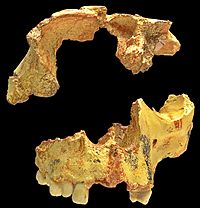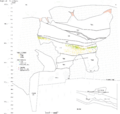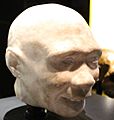Homo antecessor facts for kids
Quick facts for kids Homo antecessorTemporal range: Early Pleistocene
|
|
|---|---|
 |
|
| Scientific classification | |
| Kingdom: | |
| Phylum: | |
| Class: | |
| Order: | |
| Superfamily: | |
| Family: | |
| Genus: | |
| Species: |
H. antecessor
|
| Binomial name | |
| †Homo antecessor Bermudez de Castro et al., 1997
|
|
Homo antecessor was an early human species that lived a very long time ago. They lived between 1.2 million and 800,000 years ago. Scientists Eudald Carbonell, Juan Luis Arsuaga, and J. M. Bermúdez de Castro discovered them. Homo antecessor is one of the first human types known to live in Europe. The best fossil found is a jawbone from a 10-year-old child. It was found in Atapuerca, Spain.
Contents
What Homo antecessor Looked Like
Even though they lived so long ago, the face of Homo antecessor was surprisingly like modern humans. They might have had a wide chest and been quite heavy. This was similar to Neanderthals. However, their arms and legs were long. Their feet show that they walked differently from people today.
Tools and Where They Lived
Homo antecessor mainly made simple stone tools. They used pebbles and flakes of stone. They often used materials like quartz and chert. They lived in the inland Iberia (modern-day Spain and Portugal). They only stayed there during warm periods. When it got cold, they likely moved closer to the coast.
What Homo antecessor Ate
Scientists found fossils of sixteen different animal species mixed with Homo antecessor remains. This was at a place called Gran Dolina. Deer were the most common animal they hunted and ate. They also ate Hermann's tortoise. Tortoises were an easy source of meat because they move very slowly.
The area where they lived had a cool and wet environment. This helped trees like olive, mastic, beech, hazelnut, and chestnut grow. Homo antecessor might have eaten these plants. They also seemed to eat hackberries. These berries have little flesh. In later times, people used them more for medicine than for food.
There is no sign that Homo antecessor could use fire to cook. Their teeth show they ate tougher foods. This means they likely ate raw meat instead of cooked meat.
Related pages
Images for kids
-
Stratigraphy of the Gran Dolina with detail on TD6
-
The Happisburgh footprints with a camera lens cap for scale
-
Bust of an H. antecessor child at the Natural History Museum, London
-
H. antecessor may have moved along the Ebro river highlighted above (the Sierra de Atapuerca lies near the source).
-
Sierra de Atapuerca today: 1) Entrance to railway ditch, 2) Sima del Elefante, 3) Galería, 4) Gran Dolina
See also
 In Spanish: Homo antecessor para niños
In Spanish: Homo antecessor para niños






